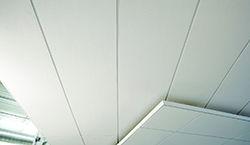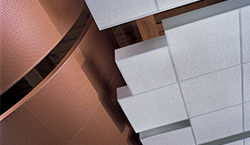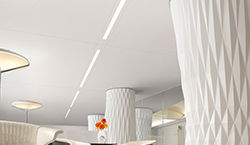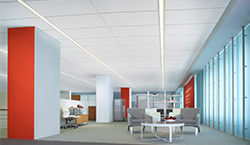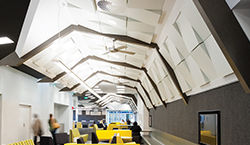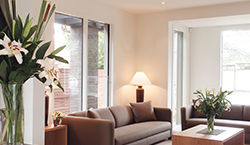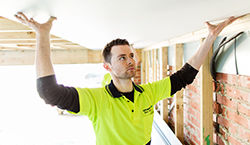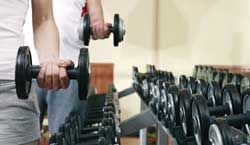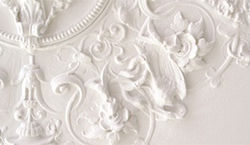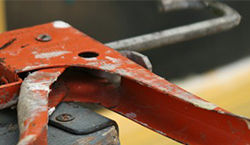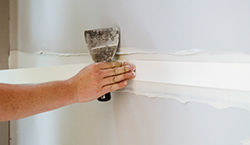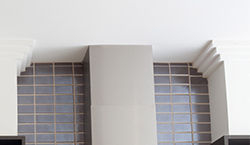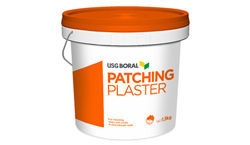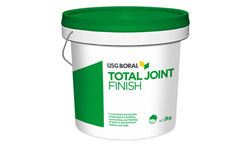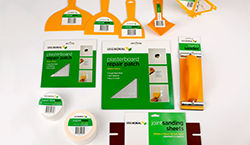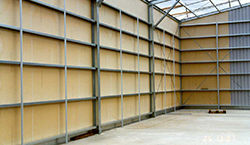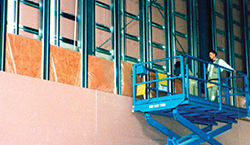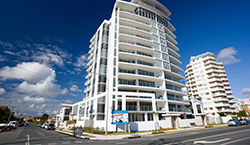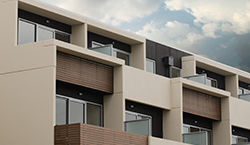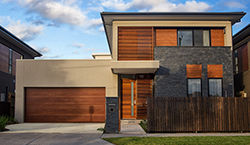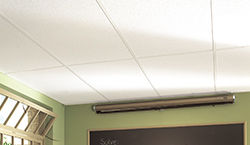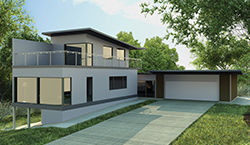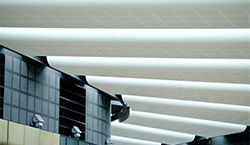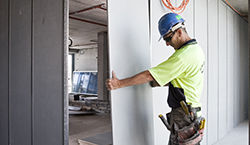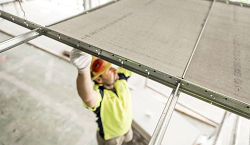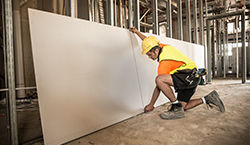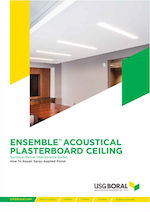There are two types of methods of suppression used in building fire safety design: passive and active. Passive suppression uses materials, systems, building elements, and/or building layout to prevent or resist ignition, to limit its spread to other combustible contents in the room and to contain the fire within the room or zone to prevent its spread to other sections of the structure.
Active suppression is the employment of mechanical devices such as sprinklers or extinguishers to extinguish the fire in its early stages to prevent its spread. Passive suppression uses the natural properties of materials and products that are part of the building design to suppress the migration of the fire. It is well known in the construction industry that the single most important characteristic of gypsum drywall is its fire resistance. This is provided by the principal raw material used in its manufacture, CaSO₄∙2H₂O (gypsum). Gypsum is non-combustible, which means that it contributes no fuel to a fire. As the chemical formula shows, gypsum contains 21% by weight chemically combined water, also called crystalline water that is part of the gypsum crystal itself.
When gypsum drywall panels are exposed to fire, the heat of the fire converts the crystalline water to steam. The heat energy that converts water to steam is thus absorbed, keeping the opposite side of the gypsum panel cool as long as there is water left in the gypsum, or until the gypsum panel is breached.
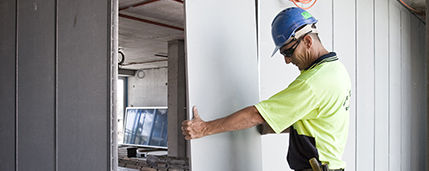
FIRE RESISTANCE LEVEL (FRL)
Fire rating requirements of the Building Code of Australia are specified in terms of Fire Resistance Level (FRL). The FRL specifies the performance, in minutes, for each of the following three design criteria when specimens are fire tested to the requirements of the Australian Standard AS 1530 Methods for Fire Tests on Building materials, Components and Structures — Part 4: Fire-Resistance Tests of Elements of Building Construction:
Structural Adequacy
The specimen can no longer carry its load (self-weight and superimposed loads).
Integrity
Cracks or openings develop that allow the passage of flames or hot gasses.
Insulation
The unexposed face temperature rises by more than 140°C on average or 180°C for a single point. For example, a wall system under fire test that carries its load for 120 minutes and maintains its integrity and insulation for 120 minutes is given a FRL of 120/120/120, ie 120 minutes structural adequacy, 120 minutes integrity and 120 minutes insulation. Systems that achieve a particular FRL can be used to satisfy the requirements for a lesser FRL.
SUPPORT
Any structure required to support a fire rated system must have a fire resistance structural adequacy level of at least that of the system. This includes vertical support to ceilings and walls and lateral support to the top of walls which may be provided from both sides. Refer to BCA for specific requirements.
ADJACENT STRUCTURE
The BCA requires that building elements, other than roof sarking or certain roof battens, must not pass through or cross a fire rated wall unless the Fire Resistance Level of that wall is maintained. Where trusses and beams pass over or through a fire rated partition, the following measures can be taken to ensure that the Fire Resistance Level of the partition is not degraded due to a failure of these members in the case of fire:
- Construct a fire rated ceiling that protects the structural members
- Fire protect the structural member, or
- Ensure the partition can carry loading from the fire affected structural member and that the member can still carry its loading when it is supported on a partition (for trusses, this can mean the inclusion of additional webbing above the partition). Ensuring the partition can carry these new loadings may require:
- Turning it into a load bearing partition
- Constructing the partition with a protected column within it, or
- Constructing unprotected columns on both sides of the partition.
PORTAL FRAME BEHAVIOUR
In portal frames affected by the fire, the rafters often push outwards on the column members until the ridge sinks and then pulls the columns inwards. Should drywall be used to provide a fire separation within portal framed buildings, the above mode of failure needs to be recognised by the designer.
As mentioned above, load bearing elements may need to be incorporated within, or adjacent to, the partition to maintain support to the roof structure during a fire event.
DIRECTION OF ATTACK BY FIRE
In most cases, the direction of attack by fire is assumed to be from both sides of the partition. In some cases, for example in exterior walls adjacent to a fire source feature (as defined in the BCA), the rating may be required from one side only.
For conventional fire rated plasterboard ceiling systems, direction of attack by fire is always from below, while for spanning ceilings it can also be from both sides or from above. Applicable fire attack direction is indicated for each fire rated system listed in this manual.
MAXIMUM HEIGHTS
Maximum heights for fire rated steel stud partitions are the lesser of maximum fire heights and structural heights for a given wall configuration and stated lateral pressure.
Maximum fire heights for USG Boral fire rated steel stud walls are derived from full scale tests carried out by CSIRO, BHP, BRANZ and from fire engineering principles. Maximum structural heights have been obtained by computation and from extensive mechanical testing. These heights meet the requirements of the National Construction Code and have been certified by Wynton Stone Australia Pty Ltd and Taylor Thomson Whitting of Melbourne.
RESISTANCE TO INCIPIENT SPREAD OF FIRE (RISF)
The NCC stipulates instances when a ceiling system must be resistant to the incipient spread of fire. This requirement determines the ability of the ceiling to provide adequate thermal insulation to combustible materials within the ceiling plenum, thus avoiding the danger of the materials being ignited.
Many USG Boral fire rated ceiling systems carry an RISF rating which is noted as such. RISF is a more onerous requirement than FRL. Systems that achieve a particular RISF may be used to satisfy the requirements of a lesser RISF.
FIRE HAZARD PROPERTIES
Wall and ceiling lining materials in certain types of buildings must comply with the Fire Hazard Properties requirements of the BCA.
All USG Boral gypsum board lining products are classified as Group 1 (least hazardous) materials and have a smoke growth rate index less than 100 and average specific extinction area less than 250m2/kg when tested in accordance with the BCA.
COMBUSTIBILITY
In accordance with the BCA, gypsum boards can be used wherever a non-combustible material is required.
GAS RETICULATION IN FIRE RATED WALLS
Oxygen or combustible fluid reticulation systems should not be located within fire rated walls unless designed, fire tested and constructed to suit this application.
USG Boral offers a wide range of fire rated building systems including;
- lightweight wall systems up to FRL –/240/240 and 180/180/180
- lightweight ceiling systems up to FRL 120/120/120
- acoustic systems with Rw+Ctr=50 or higher
- masonry upgrades and
- beam/column fire protection systems up to FRL 180/–/–




